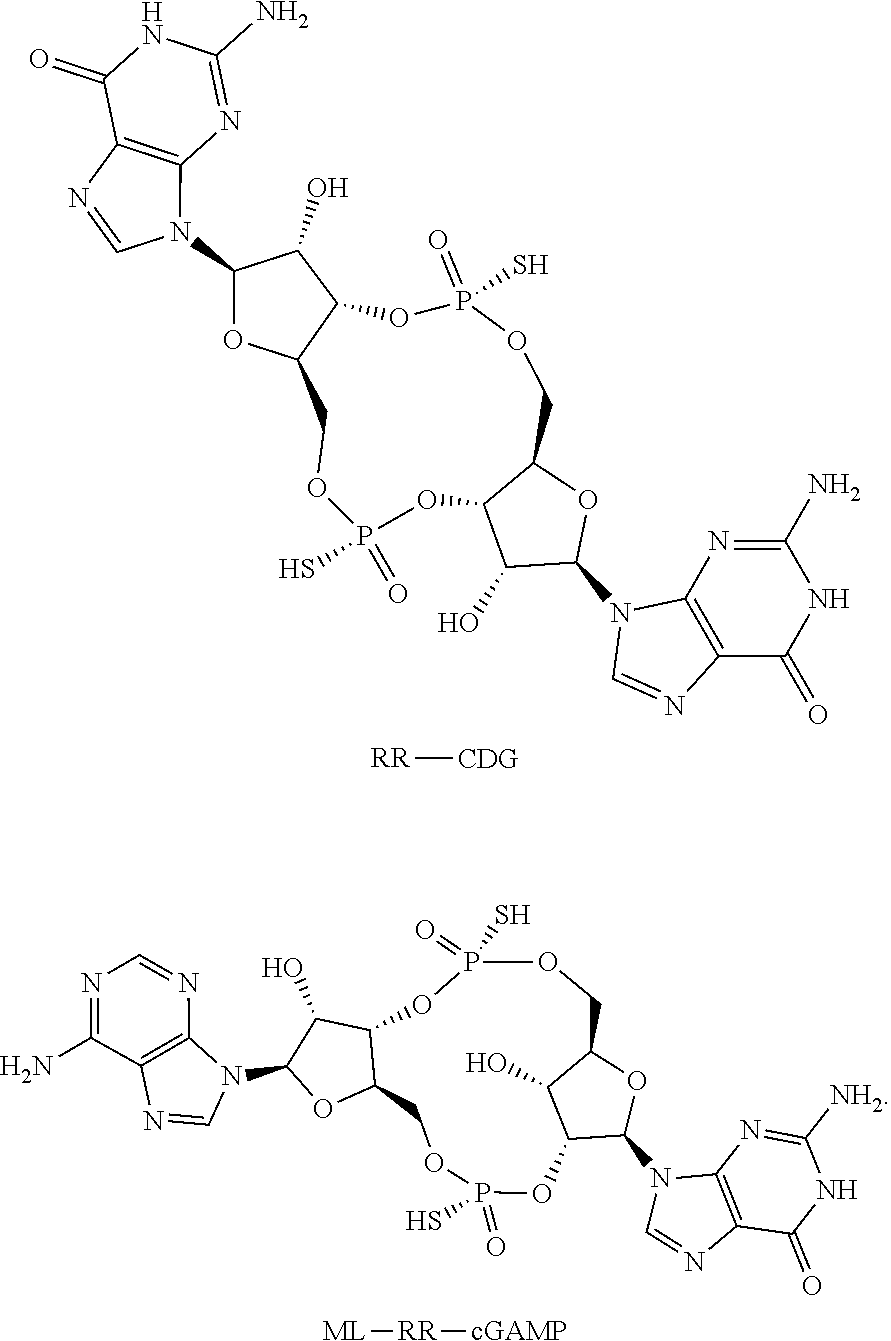Intranasal delivery of a cyclic-di-nucleotide adjuvanted vaccine for tuberculosis
a tuberculosis and cyclic-di-nucleotide technology, applied in the field of tuberculosis cyclic-di-nucleotide adjuvant vaccine intranasal delivery, can solve the problems of inability to clinically approve adjuvants, bcg is not recommended for individuals with compromised immune systems, and continues to be a leading cause of death worldwid
- Summary
- Abstract
- Description
- Claims
- Application Information
AI Technical Summary
Benefits of technology
Problems solved by technology
Method used
Image
Examples
example 1
A STING-Activating RR-CDG Adjuvanted Protein Subunit Vaccine Protects Against M. tuberculosis Infection
[0081]The efficacy of CDNs as an adjuvant for M. tuberculosis antigens was tested with a synthetic form of CDG in which the non-bridging oxygen atoms were replaced with sulfur atoms in the R,R stereochemical configuration (RR-CDG) to prevent cleavage and inactivation by host cell phosphodiesterases (Corrales et al. 2015). RR-CDG was combined with the antigen 5Ag, a fusion of five M. tuberculosis proteins: Antigen-85B (Ag85B, Rv1886c), ESAT-6 (Rv3875), Rv1733c, Rv2626c, and RpfD (Rv2389c) (Zvi et al. 2008). Ag85B and ESAT-6 are established immunogenic TB antigens that have been tested in a variety of subunit vaccines and have been shown to elicit T cell responses in humans (Weinrich Olsen et al. 2001; Horwitz et al. 1995; Baldwin et al. 1998; Brandt et al. 2000; Olsen et al. 2004; Langermans et al. 2005). Rv1733, Rv2626c, and RpfD were identified in a bioinformatics analysis that id...
example 2
Intranasal, but not Subcutaneous, Boosting of BCG with 5Ag / RR-CDG Significantly Enhances Protection from M. tuberculosis Challenge
[0089]Following the vaccination schedule (CDN prime at wk −12; CDN boosts at wk −8, −4; ICS at wk −7; ELISPOT / ICS at wk −3; CFU / ICS at wk 4; and CFU at wk 12), BCG primed mice received two boosts of 5Ag / RR-CDG or 5Ag alone via SQ injection and were compared to mice that received three injections of 5Ag / RR-CDG as described above. After the 2nd boost, ELISPOT analysis showed that BCG immunized mice boosted SQ with 5Ag / RR-CDG had increased Ag85B- and ESAT-6-specific T cell responses compared to mice that were only immunized with BCG. However, there was no difference in IFN-γ levels between mice immunized with BCG and boosted with SQ 5Ag / RR-CDG compared to mice that received three SQ administrations of 5Ag / RR-CDG alone. Additionally, boosting BCG with SQ 5Ag / RR-CDG did not result in enhanced protection against M. tuberculosis aerosol challenge.
[0090]This was ...
example 3
ML-RR-cGAMP, a Human STING Agonist, Elicits a Th17 Response and Protects Against Challenge with M. tuberculosis
[0093]RR-CDG efficiently activates murine STING; however, it does not engage all five common STING alleles in the human population (Corrales et al. 2015; Yi et al. 2013). The adjuvant activity of ML-RR-cGAMP, a dithio-substituted diastereomer of cGAMP with both a non-canonical 2′-5′ and a canonical 3′-5′ phosphodiester linkage (denoted mixed-linkage, ML) that is both resistant to hydrolysis by phosphodiesterases and a potent activator of these five common human STING alleles (Corrales et al. 2015) was tested for activity. Mice were immunized via the IN or SQ route with either 5Ag / RR-CDG or 5Ag / ML-RR-cGAMP, and the frequency of Ag85B-specific CD4+ T cells in the blood that produce either IL-17 or IFN-γ was measured 7 days after the 1st boost. Both 5Ag / RR-CDG and 5Ag / ML-RR-cGAMP vaccines elicited IFN-γ-producing and IL-17-producing CD4+ T cells when administered IN. SQ admin...
PUM
 Login to View More
Login to View More Abstract
Description
Claims
Application Information
 Login to View More
Login to View More - R&D
- Intellectual Property
- Life Sciences
- Materials
- Tech Scout
- Unparalleled Data Quality
- Higher Quality Content
- 60% Fewer Hallucinations
Browse by: Latest US Patents, China's latest patents, Technical Efficacy Thesaurus, Application Domain, Technology Topic, Popular Technical Reports.
© 2025 PatSnap. All rights reserved.Legal|Privacy policy|Modern Slavery Act Transparency Statement|Sitemap|About US| Contact US: help@patsnap.com

